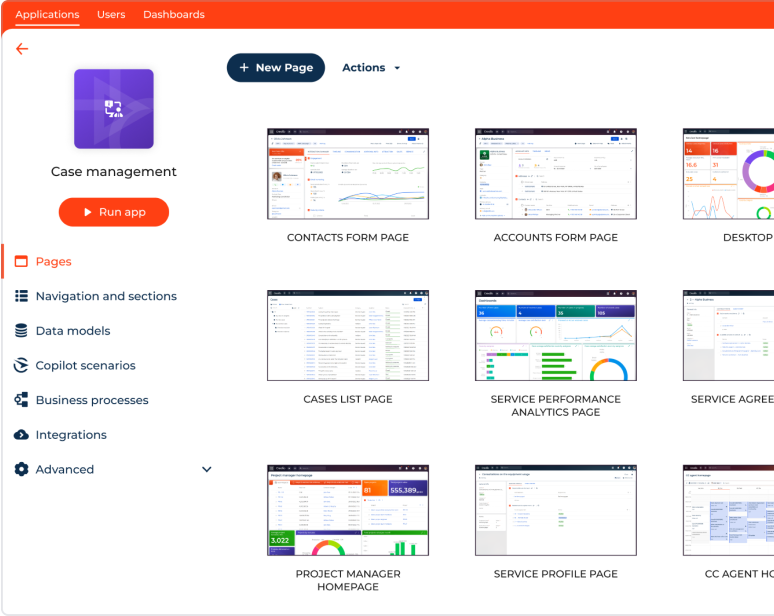-
No-Code
Platform
-
Studio
No-code agentic platform delivering the fastest time-to-value and the highest ROI
-
Studio
-
AI-Native CRM
CRM
-
AI-Native CRM
New era CRM to manage customer & operational workflows
CRM Products -
AI-Native CRM
- Industries
- Customers
- Partners
- About

In the ever-evolving landscape of technology, the demand for custom software solutions constantly increases. Traditionally, creating applications required a deep understanding of coding languages, often limiting this process to skilled developers.
However, with the emergence of no-code development platforms, the paradigm began to change, and now anyone, regardless of their coding proficiency, can bring their ideas to life with the no-code approach to app creation.
What is a No-Code Platform?
A no-code platform is a software development technology that enables users with little to no programming skills to create, customize, and deploy full-scale software applications using drag-and-drop interface, WYSIWYG visual designers, composable pre-built segments, and GenAI-powered intelligent assistants. These no-code tools offer an intuitive user interface, replacing the need to write lines of code with drag-and-drop and natural language functionality, simplifying and speeding up the creation process.
No-code app builders democratize application development by allowing professionals with diverse backgrounds to participate in the process. Users can visually compose various workflows, forms, and data necessary to build apps by using configuration tools, ready-made components, and templates, without writing a single line of code. The no-code approach accelerates the time to market and simplifies the development process, making it more accessible and efficient for both individuals and businesses.
No-code software promotes reusability by allowing to save and reuse components, templates, and workflows, streamlining the development process. Additionally, they provide integrations with third-party applications, usually available through marketplaces with pre-built connectors, and extensions, which further expand the platform's functionalities.
With the no-code approach, business and non-technical users can create back-office applications, customer-facing applications, workflow apps, digital forms, employee collaboration apps, and more. These are some of the apps that can be created with a no-code approach:
- Websites and web applications
- Databases and data management tools
- Mobile applications
- Workflow automation tools
- Sales automation
- Product lifecycle automation
- Employee lifecycle automation
- Service delivery
- Marketing campaign automation
The app development process with the no-code approach is easier and more efficient than the traditional one, which typically requires extensive coding skills and specialized training. To better understand how to build apps with the no-code approach, we will review a typical process's key stages.
Best No-Code App Builders Summary
Vendors | Best for | Features | Pricing |
|
| Pricing starts at $25/ user/ month | |
OutSystems |
|
| Pricing starts at $1,513/month |
Zapier |
|
| Pricing starts at $19.99/month |
Bubble |
|
| Pricing starts at $29/month |
Mailchimp |
|
| Pricing starts at €11,97/month |
Airtable |
|
| Pricing starts at $20/user/month |
Webflow |
|
| Pricing starts at $14/month |
Bravo |
|
| Pricing starts at $44/user/month |
Bildr |
|
| Pricing starts at $24/2 users |
Adalo |
|
| Pricing starts at $36/month/user |
The Stages of a Typical No-Code Development Process
Creating apps with no-code tools involves a structured process, empowering employees to transform their ideas into functional applications without the need for traditional coding. Each stage plays a crucial role in the overall process, providing a clear roadmap.
Let's delve into the seven stages of building apps with no-code tools:

Stage 1 - Business use cases
Before diving into the development process, it's crucial to identify and define the business use cases that the application aims to address. This initial stage involves thorough brainstorming and analysis to understand the organization's specific needs, challenges, problems, and goals.
In this stage, organizations should explore all the problems and opportunities that the application aims to address. Users, whether they are entrepreneurs, small business owners, or non-technical professionals, need to identify key pain points or areas of improvement within their organization. They should answer the “what” and “why” to understand what exactly they expect from the application they want to create before they can go to the next stage.
Let's consider a retail company aiming to enhance its customer experience and streamline operations through a mobile app. For instance, they may implement a loyalty program to boost customer engagement, integrate inventory management to optimize stock levels, and include a chatbot for instant customer support. Identifying these use cases ensures a tailored development process, aligning the app closely with business goals.
Stage 2 - Vendor analysis
Once you know your business requirements, it's time to look at the solutions available on the market. There are plenty of no-code solutions that offer distinctive features, functionalities, and pricing models. While comparing different options, you should pay attention to a few aspects such as:
- the scope of features
- flexibility and customization options
- integration options
- accessibility and ease-of-use
- governance tools
- deployment options
- scalability
- pricing
In this article, we will go over the 10 best no-code solutions that we believe have the best offers on the market to help you make the best choice for your organization.
Stage 3 - Design and prototype
It's finally time to start planning and designing your application. Once you know your requirements and choose the vendor that provides a no-code app builder best suited to your needs, you're ready for some creative work.
It's tempting to start designing specific features that will answer your immediate needs. However, during the design and prototype stage, you should focus on the whole solution, the long-term vision and architecture, rather than individual parts, and current challenges. You want your solution to be comprehensive and future-proof, so make sure you keep that in mind.
The first phase of designing an application is to define an application with all the needed parameters using no-code visual tools (e.g., fields, dashboards, UX/UI, and workflows). Rather than designing on paper, with a no-code approach, you can start building the software itself, creating a prototype, and making changes as you go.
Typically, there are at least five major design activities in this stage, which can vary, depending on the vendor:
- Composing the user interface - defining UI elements, typically with a visual forms builder equipped with a drag-and-drop functionality, pre-built elements, and templates
- Building the workflow and logic of the app - creating business rules, processes, and workflows using a visual workflow designer
- Designing the integration with other systems - using the application
- programming interfaces (APIs) or readymade connectors from the marketplace, designing how the app will integrate with other applications to ensure seamless data exchange
- Designing dashboards and analytics - visually composing dashboards and reports, using a drag-and-drop interface and prebuilt segments and widgets (e.g., bar charts, line charts)
The focus of this stage is to create the “frame” of the app, not design every last detail. If your company requires more advanced processes or integrations, it's possible to engage the professional developer team in the process. However, it's not necessary if your requirements are standard. Implementing additional features and complex functionalities may require more time and increase costs.
Stage 4 - Development
In the developmental phase of no-code app creation, you need to transform your prototype into the actual software. To create a completed solution, you need to put more work into the aspects that you loosely designed in the previous stage. This may include completing the data model, workflows, and forms, adding details to the processes and tasks, building all the required analytical reports, fine-tuning the UI, etc.
The building process is simplified and accelerated thanks to the drag-and-drop interface, where developers combine components, configure functionalities, and seamlessly integrate external services via visual connectors.
Remember that you need to test your solution and gather feedback from the stakeholders. Be ready to alter the application, add new functionalities, or remove some of its parts. The key is to make sure that the solution answers all the business requirements that were established in the first stage.
Stage 5 - Testing and feedback
Once you create the first version of the app it's time to put it into the test. You should focus on testing end-to-end scenarios that evaluate the end-user features and journeys. Depending on the number and complexity of the third-party app integrations, you may also need to test the API to make sure all the integrations work smoothly.
Unlike with traditional development, you don't need to worry about testing the technical infrastructure and environment, since they're provided by the no-code tool and are typically hidden from the developers.
Monitor user interactions and performance and gather feedback from users and stakeholders to improve the application. You don't need to wait to collect the feedback at the very end of the building process. With a no-code approach, the feedback is more continuous and can be delivered and answered constantly. Implement changes based on feedback to ensure your application meets all the requirements.
At this stage, you may also want to check the app's compliance with external and internal laws and regulations, security, and governance.
Stage 6 - Deployment
Once all the parties are satisfied with the developed solution, it's time to deploy it. With a no-code app builder, it's as simple as clicking one button, and the app is moved to production.
During deployment, the application is published and accessible. Existing data is transitioned into the live environment and the app is ready to be used. However, businesses need to prepare documentation and application guides and provide onboarding for their users before the application can bring tangible benefits to the organization.
Stage 7 - Continuous improvement
Businesses should continuously monitor the application's performance and optimize as needed. With monitoring tools and feedback from users, they can implement changes, and add functionalities as they go.
To find out more about the no-code app creation process, make sure to download our free No-code Playbook!
3 Requirements for Building Applications With No-Code
Building applications with no-code platforms involves three essential steps:
- Structuring the database - creating and organizing tables, fields, and relationships to store and manage data in the app. No-code app builders usually provide intuitive tools to set up databases without requiring SQL knowledge.
- Composing the user interface - designing and customizing the application's appearance with drag-and-drop editors to create layouts, and add components like buttons, forms, and media. This step focuses on the visual and interactive aspects of the app, ensuring that users can easily navigate and use its features.
- Building the app's logic - defining how the application behaves and responds to actions. This includes setting up workflows, automations, and conditional logic to handle tasks such as data processing, authentication, and notifications.
By following these steps, organizations can create robust and functional apps, streamlining the creation process.
No-code Playbook
Discover how to build complex business applications effortlessly—grab your free 200-page No-Code Playbook now!

10 Best No-code App Building Platforms
In the dynamic landscape of no-code app development, a multitude of platforms have emerged, each with unique abilities. Below, we delve into the core features, advantages, drawbacks, and pricing models of the top 10 no-code platforms, to help you make an informed decision about the best solution for your needs.
1. Creatio
Creatio Studio stands out as the best no-code development platform offering a comprehensive and versatile solution for businesses seeking efficient and tailored application development software. Thanks to its exceptional customization and configuration capabilities, coupled with an innovative composable architecture, it is highly adaptable for various industries, workflows, and use cases.

Creatio offers an intuitive and flexible user interface that empowers non-technical users to effortlessly automate workflows and create applications with a maximum degree of freedom, without writing even a single line of code. Studio’s composable architecture provides pre-built reusable components, such as actions, buttons, data fields, forms, etc., that can be dragged and dropped to build new applications. Robust AI capabilities assist users in the development process, making it even more accessible to citizen developers.
With Creatio's visual no-code tools, organizations can build powerful business applications, and automate business processes and workflows of any complexity in hours, instead of days or weeks. The Freedom UI Designer within Creatio Studio further expedites the process by providing an extensive library of predefined templates, views, and widgets. If needed, professional developers can further customize applications with coding to meet specific business requirements, however, it's an optional feature, rather than a necessity.
Creatio's potential can be further enriched, thanks to its robust integration and an extensive marketplace of over 700 applications and connectors. This ensures that the software seamlessly integrates into the toolset and allows for the undisturbed flow of data between different tools.
With Creatio, businesses can rest assured that their data and privacy are protected, thanks to robust security measures, including data encryption. It ensures that sensitive information is safeguarded, and compliance with industry regulations is maintained. Creatio also provides governance features with over 100 recommended policy configurations, as well as features for enforcing custom policies. Creatio Studio scales seamlessly with growing organizations, accommodating their evolving needs and requirements. It's an ideal solution for both small-scale projects and managing enterprise-level applications.
Pricing
Creatio offers a fully transparent, composable pricing model that allows organizations to add specific features as required, without increasing the costs of ownership. With pricing models starting at $25 per user per month, Creatio is the best choice for medium to large firms.
Rating
Gartner 4,9 ⭐
2. OutSystems
OutSystems is an enterprise-grade no-code and low-code app development platform, that enables businesses to build apps of varying complexity. It provides a feature-rich application creation environment with modular elements, and it's the preferred choice for larger enterprises seeking rapid and efficient options.

Pros
OutSystems provides an extensive library of pre-built templates, and components, expediting the no-code app creation process. The visual environment can also be expanded with custom code accessible to professional developers. The platform also supports model-driven development and offers robust tools for data modeling and integration.
With OutSystems, organizations can create various applications to support back-office and sales processes, and industry-specific workflows that improve operation efficiency in industries such as healthcare, insurance, and banking. Thanks to advanced security features, OutSystems ensures the protection of sensitive organization data and compliance with governance standards. The automation is empowered by robust AI tools that make suggestions for the next best component that can be used in the workflow.
Cons
While OutSystems excels in scalability and performance, the high costs of licensing and subscription may present a barrier for smaller organizations with budget constraints. Additionally, users might encounter a learning curve, particularly when exploring advanced functionalities. Although OutSystems provides a range of pre-built elements and templates, the customization options for citizen developers are quite limited. Since OutSystems caters mostly to professionals helping them accelerate the development process, it's not the best choice for business developers.
Pricing
OutSystems provides a free pricing model for a single app and a multiple applications model which starts at $1,513 per month. OutSystems also offers a customized pricing model based on individual business requirements, which can be obtained through their sales team.
Rating
Gartner 4,5 ⭐
See also: Top 10 OutSystems Competitors & Alternatives
3. Zapier
Zapier is a renowned automation-first platform, specializing in connecting various apps and automating workflows. Organizations can seamlessly integrate over 6000 applications, create powerful workflow automation, and conditional filters to enhance overall efficiency.

Pros
Zapier offers a vast library of supported third-party apps and integrations, providing flexibility in workflow creation. Its straightforward and intuitive interface makes automation accessible to people with varying technical skills, and real-time automation contributes to increased productivity. Intuitive interface helps organizations create mini web apps with landing pages, chatbots, and various forms, and connect diverse sources with Zapier Tables. Zapier further enhances its abilities with AI tools.
Cons
Zapier is simpler and less flexible than other platforms on this list and has limitations in implementing complex logic and conditional actions. Since pricing scales with usage, it can lead to increased costs for heavy users.
Pricing
Zapier offers a tiered pricing structure based on the number of tasks and applications involved. It provides a free plan, and three other plans, which start at $19.99 per month.
Rating
Gartner 4,8 ⭐
4. Bubble
Bubble is a versatile no-code solution enabling the creation of web applications through a visual programming interface. Offering extensive customization options, an intuitive environment, and a visual editor, Bubble is favored by companies seeking a visual approach to designing custom applications without coding.

Pros
Bubble stands out as an intuitive and easy-to-use solution for software development and building applications, dashboards, CRMs, social networks, and more. Its extensive customization options equipped with a library of visual elements allow organizations to tailor applications to their specific needs. It also offers the freedom to extend the platform's functionality with JavaScript plugins and API integrations. Bubble ensures seamless teamwork with its access-controlled collaboration feature and allows for real-time changes which streamlines the whole creation process.
Bubble provides a responsive design and scalable infrastructure with simple deployment and hosting. It offers a range of features for building logic and privacy rules, setting up user management, and exporting and managing databases using Excel or CSV files. It also oversees security with free SSL certificates and multi-factor authentication.
Cons
Although Bubble is a user-friendly solution, some users may encounter a learning curve when dealing with complicated applications. Additionally, Bubble's mobile app development features are rather limited in comparison to its web functionality.
Pricing
Bubble provides various pricing plans, including a free tier with basic functionalities. Paid plans offer advanced features and increased usage and start at $29 per month.
Rating
Gartner 4,4 ⭐
5. Mailchimp
Mailchimp, known for its efficiency in email marketing, extends its services to a no-code tool, allowing businesses to create landing pages, websites, and more. Simplifying the process of designing and launching marketing campaigns, Mailchimp's offering requires no coding skills.

Pros
Mailchimp seamlessly integrates with its email marketing tools, offering a unified marketing solution. The user-friendly interface makes it accessible to people of varying technical backgrounds. With Mailchimp, businesses can efficiently segment their customer databases, launch social media campaigns, and use analytics functionalities for tracking campaign performance. The platform also offers over 300 integrations with third-party apps like Shopify and Squarespace Commerce, making it a smart choice for smaller companies looking to automate their marketing efforts.
Cons
Mailchimp is primarily focused on marketing-related applications, which limits its scope for more diverse app creation. Organizations seeking complex application features may find the platform somewhat constraining, and not versatile enough.
Pricing
Mailchimp offers a free plan with basic features and paid plans which provide additional functionalities and are tiered based on the number of contacts. Paid plans start at €11,97/month, making it an affordable solution even for small organizations.
Rating
Gartner 4,3 ⭐
6. Airtable
Airtable combines spreadsheet flexibility with a powerful database, offering a versatile no-code platform for creating collaborative and customizable databases with a modular system. It caters to a wide range of use cases, from project management to content planning, enhancing its functionalities with generative AI.
Pros
Airtable's versatility shines in organizing and managing data. It helps businesses create flexible database-driven projects, automate workflows, and organize work without coding. Airatble's functionality is expanded with hundreds of integrations available through API that connects the platform to third-party apps like Google Sheets, Slack, Gmail, Facebook, etc.
Cons
However, advanced features may present a learning curve for users new to the platform. While Airtable offers automation, it may be more limited than dedicated workflow tools, so it's not the best option for companies looking for a comprehensive automation tool.
Pricing
Airtable provides a free plan with basic features. Paid plans offer increased storage, advanced features, and collaboration tools, and the pricing starts at $20 per user per month.
Rating
Gartner 4,6 ⭐
7. Webflow
Webflow is a visual website development platform designed for creating responsive websites and e-commerce stores with no-code tools. With a visually driven interface, it caters to designers and organizations aiming to create professional websites without engaging in extensive coding.

Pros
Webflow offers powerful design features, a variety of responsive templates, and intuitive drag-and-drop UI, enabling the creation of visually pleasing websites. User-friendly design tools streamline the web-building process, and responsive design features ensure a seamless user experience across various devices. Additionally, Webflow offers a wide range of integrations with platforms like MailChimp, Slack, HubSpot, and more.
Cons
Webflow is a user-friendly platform, however, beginners may encounter a learning curve. Additionally, the lower-tier plans may have limited e-commerce features compared to higher-tier plans, making the Webflow no-code development platform pricier than other options for smaller businesses on the market.
Pricing
Webflow offers various pricing plans, including a free tier. Paid plans start at $14 per month for relatively simple, static sites and can go up to $39 per month for organizations wanting to create larger websites.
Rating
G2 4,4 ⭐
8. Bravo
Bravo is a no-code tool focusing on turning design files into functional applications. Streamlining the transition from design to app, Bravo allows designers and creatives to develop mobile apps from design prototypes.

Pros
Bravo facilitates a seamless transition from design to the app, allowing creators to convert Figma designs into prototypes and then develop native mobile apps for iOS and Android using a visual design interface. Bravo offers an extensive collection of visual elements, such as sliders, modal pages, pre-built templates, and reusable parts like charts and filters, that accelerate the app-building process. Real-time previews and testing offer immediate feedback, enhancing the design process, and support for various design tools and formats adding to its versatility. Thanks to integration with Google Play and Apple Store, the finished application can be published directly from Bravo's no-code apps builder, making it a good option for organizations focused on mobile apps.
Cons
Primarily focused on mobile apps, Bravo has a limiting scope for those interested in creating web applications. Additionally, firms seeking complex logic and workflows may find that the platform doesn't meet their expectations.
Pricing
Bravo offers pricing plans based on usage and features, offering a free plan for organizations and individuals wanting to start their adventure with mobile apps. Paid plans start at $44 per user per month with at least 10 users, making it a pricy platform, especially for small businesses.
Rating
G2 4,8 ⭐
9. Bildr
Bildr is a developer-focused visual development studio. Its decentralized web-building platform is designed to help create scalable data-driven web apps for Web 3.0. It offers a full-stack visual web development environment that can be used to create SaaS apps, internal tools, marketing hubs, Chrome extensions, and more. With an intuitive visual interface, drag-and-drop functionality, and integration, Bildr empowers people to create web and mobile applications that meet specific business

Pros
Bildr approach to creating apps is all about bringing no-code and code together, so it's a more technically demanding option than other vendors presented in this article. Thanks to its visual no-code framework, Bildr allows businesses to accelerate the creation of applications, which can be further customized with full JavaScript, JSON, HTML, and CSS if needed. It offers an infinite canvas that allows to view all their pages in one place and organize and layer them into separate workstations. Real-time collaboration functionalities enable updates to be visible to all collaborators on all devices in real time, improving their efficiency.
Cons
Although Bildr is perceived as a no-code tool, users reported that to create complex applications, some knowledge about coding and Web 3.0 is required. Because of that Bildr is not a solution suitable for non-technical and business users.
Bildr doesn't offer an on-premises deployment option, so organizations cannot manage and store data on their own servers, and according to its users, connecting various databases to the system can be challenging. Bildr is better suited for organizations that have both professionals and non-technical users in their team, who can collaborate on delivering the best solutions. It might be a good option for organizations that want to create simple and decentralized Web 3.0 applications, rather than complex enterprise solutions requiring extensive customization and integration.
Pricing
Bildr offers various pricing plans, including a free tier with basic features. Paid plans cater to increased usage and advanced functionalities and start at $24 per month for 2 users.
10. Adalo
Adalo emphasizes simplicity in no-code app development, offering a platform for creating interactive mobile and web applications rapidly. With a user-friendly design interface and pre-built components, Adalo makes app creation accessible to a broad range of users.

Pros
Adalo excels in rapid application creation, allowing users to bring their ideas to life quickly. The user-friendly design interface and drag-and-drop functionality enhance accessibility for users with varying technical skills, and pre-built elements streamline the prototyping process. To expand its usability, Adalo supports connectors to APIs, CRMs, and various plugins. It's a good solution for businesses wanting to create small and medium-scale apps.
Cons
The lower-tier plans may have limited customization options compared to higher-tier plans, and more advanced options come at a higher cost. Users delving into advanced features may also need to invest time in additional learning. Users reported problems with unresponsive customer service and with the scalability of the apps, which are slowing down as the user base grows. Adalo also lacks General Data Protection Regulation (GDPR) support, which makes launching apps on the EU market challenging.
Pricing
Adalo offers a free pricing plan as well as 4 paid plans, that start at $36 per month for 1 user. With paid plans, users can increase the number of editors, increase the number of applications published, and expand the range of functionalities of the platform.
Rating
G2 4,6 ⭐
By exploring the distinctive features and nuances of each platform, users can make informed choices aligned with their specific goals. From automating workflows to designing websites and developing robust business applications, these no-code and low-code platforms empower individuals and organizations to bring their digital visions to life with ease and speed.
Create Your App with No-Code
You can start your app development journey with no-code platforms regardless of your technical skills. Thanks to their revolutionizing features, you can build powerful applications tailored to your unique needs, automate workflows, and streamline processes without relying on the IT department and professional developers. This approach accelerates time-to-market, reduces costs, and lets you focus on what truly matters – bringing value to your users and stakeholders. With a no-code solution, your app-building process is always aligned with the needs of your business, empowering you to innovate and adapt swiftly to changing market demands.






















































